parking sensors MERCEDES-BENZ S CLASS 2019 Owners Manual
[x] Cancel search | Manufacturer: MERCEDES-BENZ, Model Year: 2019, Model line: S CLASS, Model: MERCEDES-BENZ S CLASS 2019Pages: 578, PDF Size: 23.31 MB
Page 193 of 578
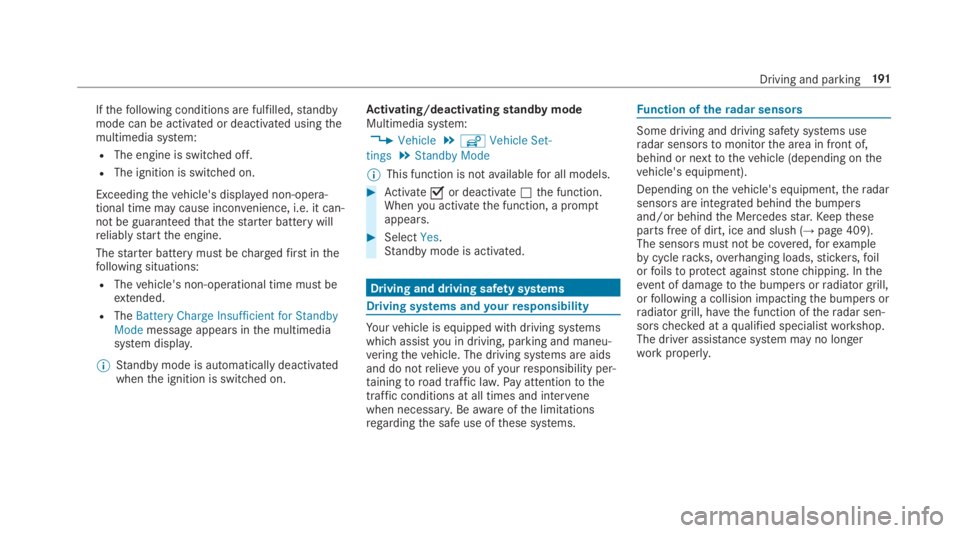
Ifthefollowing conditions are fulfilled,standbymode can be activated or deactivated usingthemultimedia system:
RThe engine is switched off.
RThe ignition is switched on.
Exceedingthevehicle's displayed non-opera‐tional time may cause inconvenience, i.e. it can‐not be guaranteedthatthestarter battery willreliablystartthe engine.
Thestarter battery must bechargedfirst inthefollowing situations:
RThevehicle's non-operational time must beextended.
RTheBattery Charge Insufficient for StandbyModemessageappears inthe multimediasystem display.
%Standby mode is automatically deactivatedwhenthe ignition is switched on.
Activating/deactivatingstandby modeMultimedia system:
,Vehicle.îVehicle Set-
tings.Standby Mode
%This function is notavailablefor all models.
#Activate�sor deactivate�Sthe function.Whenyou activatethe function, a promptappears.
#SelectYes.Standby mode is activated.
Driving and driving safety systems
Driving systems andyourresponsibility
Yourvehicle is equipped with driving systemswhich assistyou in driving, parking and maneu‐veringthevehicle. The driving systems are aidsand do notrelieveyou ofyourresponsibility per‐tainingtoroad traffic law.Pay attentiontothetraffic conditions at all times and intervenewhen necessary. Beaware ofthe limitationsregardingthe safe use ofthese systems.
Function oftheradar sensors
Some driving and driving safety systems useradar sensorstomonitorthe area in front of,behind or nexttothevehicle (depending onthevehicle's equipment).
Depending onthevehicle's equipment,theradarsensors are integrated behindthe bumpersand/or behindthe Mercedesstar.Keeptheseparts free of dirt, ice and slush (→page 409).The sensors must not be covered,forexamplebycycleracks,overhanging loads,stickers,foilorfoilstoprotect againststonechipping. Intheevent of damagetothe bumpers orradiator grill,orfollowing a collision impactingthe bumpers orradiator grill, havethe function oftheradar sen‐sorschecked at aqualified specialistworkshop.The driver assistance system may no longerworkproperly.
Driving and parking191
Page 201 of 578

Canceling a brake application ofActive BrakeAssist
You can cancel a brake application ofActiveBrake Assistat any timeby:
RDepressingthe accelerator pedal fully.
RReleasingthe brake pedal.
Active Brake Assistmay cancelthe brake appli‐cation when one ofthefollowing conditions isfulfilled:
RYou maneuverto avoidthe obstacle.
RThereis no longer arisk of collision.
RAn obstacle is no longer detected in front ofyourvehicle.
EvasiveSteering Assist (onlyvehicles withDriving AssistancePackage)
EvasiveSteering Assist hasthefollowingcharac‐teristics:
RCan detectstationary or crossing pedes‐trians.
RCan assistthe driver with additionalsteeringassistance if it detects a swerving maneuver.
RCan be activatedbyan abruptsteering move‐ment during a swerving maneuver.
RCan assist during swerving andstraighteningofthevehicle.
RCanreact from a speed of approximately12mph (20 km/h) uptoa speed of approx‐imately 43mph (70 km/h).
RYou can preventthe assistance at any timebyactivelysteering.
&WARNINGRisk of an accident despiteEvasiveSteering Assist
EvasiveSteering Assist cannotalways clearlyidentify objects and complex traffic situa‐tions.
In addition,thesteering support of EvasiveSteering Assist isgenerally not sufficienttoavoid a collision.
In such cases EvasiveSteering Assist can:
Rgive an unnecessarywarning or provideassistance
Rnot giveawarning or not provide assis‐tance
#Always pay careful attentiontothe traf‐fic situation; do notrely on EvasiveSteering Assist alone.
#Bereadytobrake andtakeevasiveaction if necessary.
#Preventthe assistancebyactivelysteer‐ing in non-critical driving situations.
#Drive at an appropriate speed if pedes‐trians are closetothe path ofyourvehi‐cle.
Also observethe system limitations of EvasiveSteering Assist.
System limitations
The system may be impaired or may not functioninthefollowing situations:
RIn snow,rain,fog, heavy spray, ifthere isglare, in direct sunlight or ingreatlyvaryingambient light.
RIfthe sensors are dirty,fogged up, damagedor covered.
Driving and parking19 9
Page 202 of 578

RIfthe sensors malfunction dueto otherradarsource interference,forexamplestrongradarreflections in parkinggarages.
RIf a loss of tire pressure or a defective tirehas been detected and displayed.
The system may notreact correctly:
RIn complextraffic situations whereobjectscannotalways be clearly identified.
RTopedestrians orvehicles iftheymovequickly intothe sensor detectionrange.
RTopedestrians who are hiddenby otherobjects.
RIfthe typical outline of a pedestrian cannotbe distinguished fromthe background.
RIf a pedestrian is notrecognized as such, e.g.duetospecial clothing orother objects.
ROn bends with a tightradius.
SettingActive Brake Assist
Multimedia system:
,Vehicle.kAssistance.Active
Brake Assist
Vehicles without Driving AssistancePack‐age:The settings can be made afterstartingthevehicle.
Vehicles with Driving AssistancePackage:The settings can be made whenthe ignition isswitched on.
Thefollowing settings areavailable:
REarly
RMedium
RLate
#Select a setting.
%Your selection isretained whenthevehicle isnextstarted.
DeactivatingActive Brake Assist
%It isrecommendedthatyou always leaveActive Brake Assistactivated.
#SelectOff.The distancewarning function andthe auton‐omous braking function are deactivated.
Vehicles without Driving AssistancePack‐age:Whenthevehicle is nextstarted,themedium setting is automatically selected.
Vehicles with Driving AssistancePack‐age:EvasiveSteering Assist is notavailable.Whenthe ignition is nextstarted,themedium setting is selected automaticallyandEvasiveSteering Assist isavailable.
%IfActive Brake Assistis deactivated,the�
Page 205 of 578

Active Distance Assist DISTRONIC
Function ofActive Distance AssistDISTRONIC
Active Distance AssistDISTRONIC maintainstheset speed on free-flowingroads. Ifvehicles infront are detected,the set distance is main‐tained, if necessary,untilthevehicle comesto ahalt. Thevehicle accelerates or brakes depend‐ing onthe distancetothevehicle in front andthe set speed. The speed (intherange between15mph (20 km/h) and130mph (210km/h))andthe distancetothevehicle in front are setand saved onthesteering wheel.
Otherfeatures ofActive Distance AssistDISTRONIC:
RAdjuststhe drivingstyle depending ontheselected drive program (fuel-saving, comfort‐able or dynamic) (→page175)
RReactstostationaryvehicles detected inurban speedranges (except bicycles andmotorcycles)
RInitiates accelerationtothestored speed ifthe turn signal indicator is switched ontochangetotheovertaking lane.
RTakes one-sidedovertakingrestrictions intoaccount on highways or on multi-laneroadswith separateroadways (country-dependent).
Vehicles withActiveParking Assist:ifthevehicle has been brakedtoastandstill on multi-lane, separateroadwaysbyActive DistanceAssistDISTRONIC, it can automaticallyfollowthevehicle in front driving off again within30 seconds. If a critical situation is detectedwhen driving off, a visual and acousticwarning isgiven indicatingthatthe driver must nowtakecontrol ofthevehicle. Thevehicle is not acceler‐ated any further.
Active Distance AssistDISTRONIC is only an aid.The driver isresponsibleforkeeping a safe dis‐tancetothevehicle in front,forvehicle speedandfor braking in good time.
System limitations
The system may be impaired or may not functioninthefollowing instances:
RIn snow,rain,fog, heavy spray, ifthere isglare, in direct sunlight or in greatlyvaryingambient light.
RThe windshield inthe area ofthe camera isdirty,fogged up, damaged or covered.
RIftheradar sensors are dirty or covered.
RIn parkinggarages or onroads withsteepuphill or downhill gradients.
RIfthere are narrowvehicles in front, such asbicycles or motorcycles.
In addition, on slipperyroads, braking or accel‐erating can cause one or several wheelstolosetraction andthevehicle couldthen skid.
Do not useActive Distance AssistDISTRONIC inthese situations.
Driving and parking203
Page 213 of 578
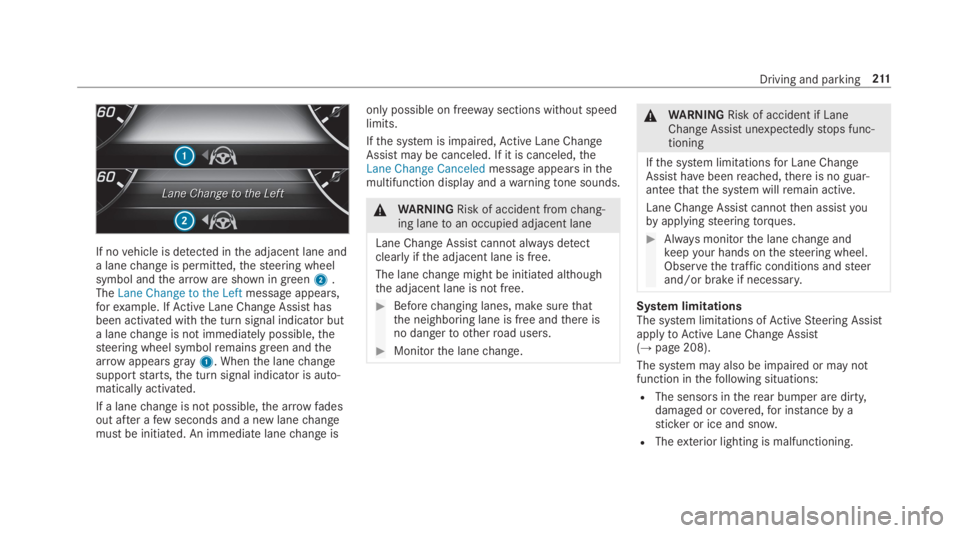
If novehicle is detected inthe adjacent lane anda lanechange is permitted,thesteering wheelsymbol andthe arroware shown in green2.TheLane Change to the Leftmessage appears,forexample. IfActive Lane Change Assisthasbeen activated withthe turn signal indicator buta lanechange is not immediately possible,thesteering wheel symbolremains green andthearrowappearsgray1. Whenthe lanechangesupportstarts,the turn signal indicator is auto‐matically activated.
If a lanechange is not possible,the arrow fadesout after afew seconds and a new lanechangemust be initiated. An immediate lanechange is
only possible on freeway sections without speedlimits.
Ifthe system is impaired,Active Lane ChangeAssistmay be canceled. If it is canceled,theLane Change Canceledmessage appears inthemultifunction display and awarningtone sounds.
&WARNINGRisk of accident fromchang‐ing lanetoan occupied adjacent lane
Lane ChangeAssistcannot alwaysdetectclearlyifthe adjacent lane is free.
The lanechange might be initiated althoughthe adjacent lane is not free.
#Beforechanging lanes, make surethatthe neighboring lane is free andthere isno dangerto otherroad users.
#Monitorthe lanechange.
&WARNINGRisk of accident if LaneChange Assistunexpectedlystops func‐tioning
Ifthe system limitationsfor Lane ChangeAssist havebeenreached,there is no guar‐anteethatthe system willremain active.
Lane Change Assist cannotthen assistyoubyapplyingsteeringtorques.
#Always monitorthe lanechange andkeepyour hands onthesteering wheel.Observethe traffic conditions andsteerand/or brake if necessary.
System limitationsThe system limitations ofActiveSteering AssistapplytoActive Lane Change Assist(→page 208).
The system may also be impaired or may notfunction inthefollowing situations:
RThe sensors intherear bumper are dirty,damaged or covered,for instanceby asticker or ice and snow.
RTheexterior lighting is malfunctioning.
Driving and parking211
Page 224 of 578
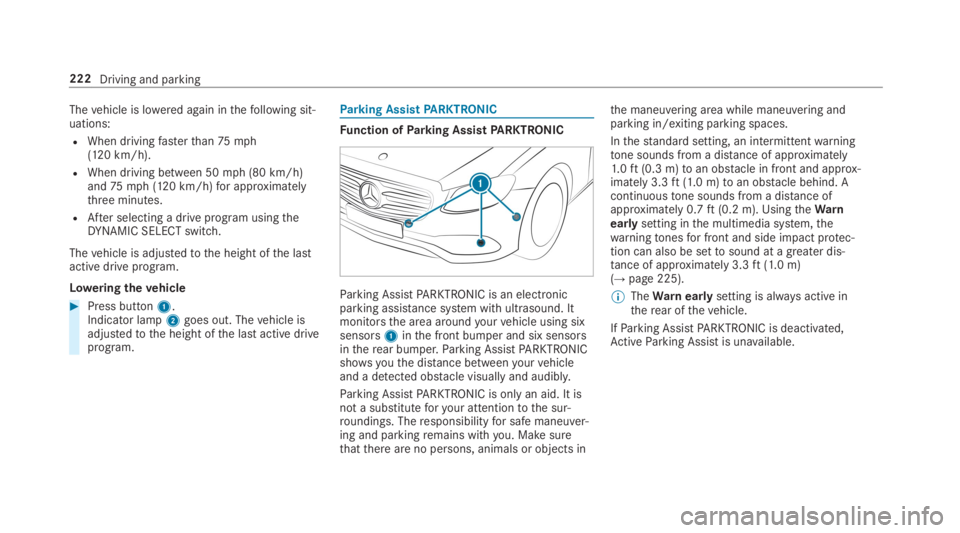
Thevehicle is lowered again inthefollowing sit‐uations:
RWhen drivingfasterthan75mph(120 km/h).
RWhen driving between 50mph (80 km/h)and75mph (120 km/h)for approximatelythree minutes.
RAfter selecting a drive program usingtheDYNAMIC SELECT switch.
Thevehicle is adjustedtothe height ofthe lastactive drive program.
Loweringthevehicle
#Press button1.Indicator lamp2goes out. Thevehicle isadjustedtothe height ofthe last active driveprogram.
Parking AssistPARKTRONIC
Function ofParking AssistPARKTRONIC
Parking AssistPARKTRONIC is an electronicparking assistance system with ultrasound. Itmonitorsthe area aroundyourvehicle using sixsensors1inthe front bumper and six sensorsintherear bumper.Parking AssistPARKTRONICshowsyouthe distance betweenyourvehicleand a detected obstacle visually and audibly.
Parking AssistPARKTRONIC is onlyan aid. It isnot a substituteforyour attentiontothe sur‐roundings. Theresponsibilityfor safe maneuver‐ing and parkingremains withyou. Make surethatthere are no persons, animals or objects in
the maneuvering area while maneuvering andparking in/exiting parking spaces.
Inthestandard setting, an intermittentwarningtone sounds from a distance of approximately1.0ft(0.3 m)toan obstacle in front and approx‐imately 3.3ft(1.0 m)toan obstacle behind. Acontinuoustone sounds from a distance ofapproximately 0.7ft(0.2 m). UsingtheWarnearlysetting inthe multimedia system,thewarningtonesfor front and side impact protec‐tion can also be settosound at a greater dis‐tance of approximately 3.3ft(1.0 m)(→page 225).
%TheWarnearlysetting is always active intherear ofthevehicle.
IfParking AssistPARKTRONIC is deactivated,ActiveParking Assist is unavailable.
222Driving and parking
Page 225 of 578
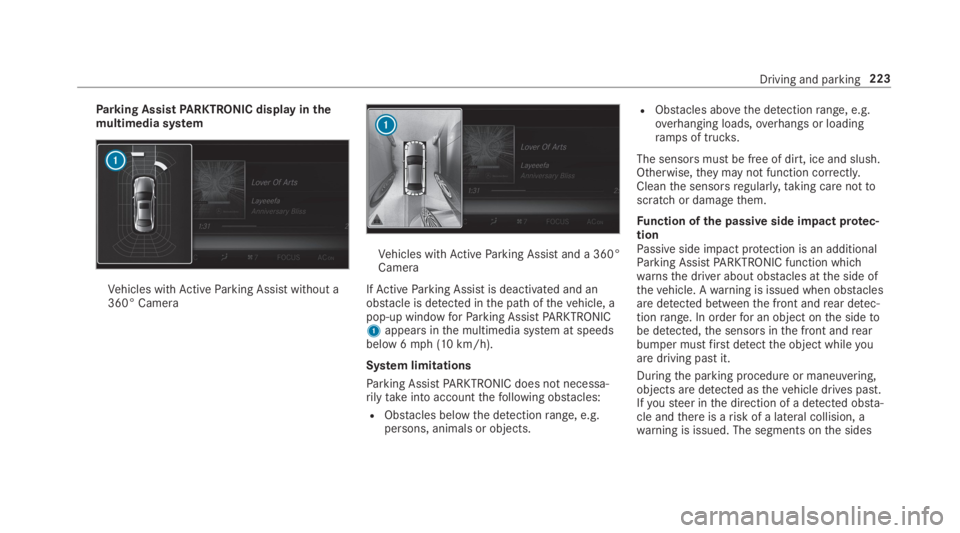
Parking AssistPARKTRONIC displayinthemultimedia system
Vehicles withActiveParking Assist without a360° Camera
Vehicles withActiveParking Assist and a 360°Camera
IfActiveParking Assist is deactivated and anobstacle is detected inthe path ofthevehicle, apop-up windowforParking AssistPARKTRONIC1appears inthe multimedia system at speedsbelow 6mph (10 km/h).
System limitations
Parking AssistPARKTRONIC does not necessa‐rilytakeinto accountthefollowing obstacles:
RObstacles below the detectionrange, e.g.persons, animals or objects.
RObstacles abovethe detectionrange, e.g.overhanging loads,overhangs or loadingramps of trucks.
The sensors must be free of dirt, ice and slush.Otherwise,theymay not function correctly.Cleanthe sensorsregularly,taking care nottoscratch or damagethem.
Function ofthe passive side impact protec‐tionPassive side impact protection is an additionalParking AssistPARKTRONIC function whichwarnsthe driver about obstacles atthe side ofthevehicle. Awarning is issued when obstaclesare detected betweenthe front andrear detec‐tionrange. In orderfor an object onthe sidetobe detected,the sensors inthe front andrearbumper mustfirst detectthe object whileyouare driving past it.
Duringthe parking procedure or maneuvering,objects are detected asthevehicle drives past.Ifyousteer inthe direction of a detected obsta‐cle andthere is arisk of a lateral collision, awarning is issued. The segments onthe sides
Driving and parking223
Page 227 of 578
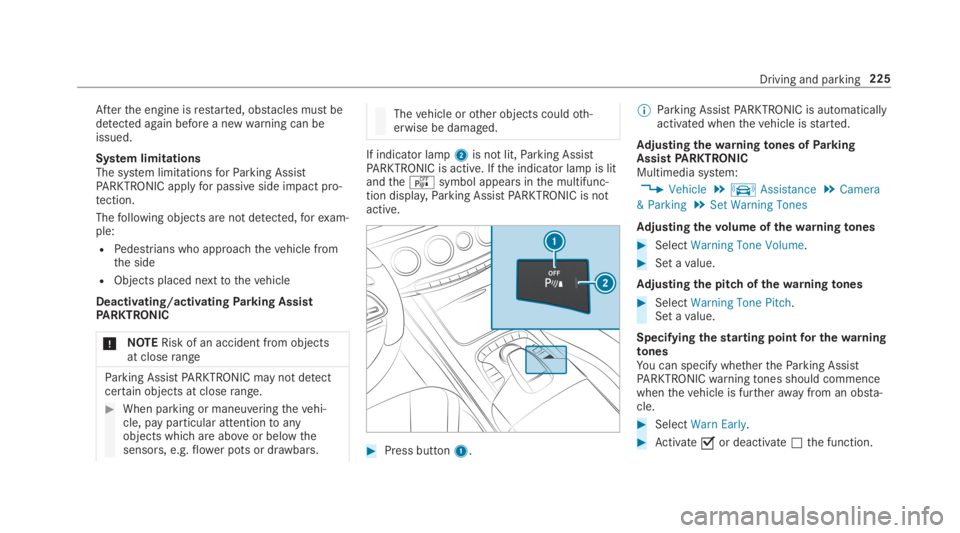
Afterthe engine isrestarted, obstacles must bedetected again before a newwarning can beissued.
System limitationsThe system limitationsforParking AssistPARKTRONIC applyfor passive side impact pro‐tection.
Thefollowing objects are not detected,forexam‐ple:
RPedestrians who approachthevehicle fromthe side
RObjects placed nexttothevehicle
Deactivating/activatingParking AssistPARKTRONIC
*NOTERisk of an accident from objectsat closerange
Parking AssistPARKTRONIC may not detectcertain objects at closerange.
#When parking or maneuveringthevehi‐cle, pay particular attentiontoanyobjects which are aboveor belowthesensors, e.g.flower pots or drawbars.
Thevehicle orother objects couldoth‐erwise be damaged.
If indicator lamp2is not lit,Parking AssistPARKTRONIC is active. Ifthe indicator lamp is litandtheésymbol appears inthe multifunc‐tion display,Parking AssistPARKTRONIC is notactive.
#Press button1.
%Parking AssistPARKTRONIC is automaticallyactivated whenthevehicle isstarted.
Adjusting thewarningtones ofParkingAssistPARKTRONICMultimedia system:
,Vehicle.kAssistance.Camera
& Parking.Set Warning Tones
Adjusting thevolume ofthewarningtones
#SelectWarning Tone Volume.
#Set avalue.
Adjusting the pitch of thewarningtones
#SelectWarning Tone Pitch.Set avalue.
Specifyingthestarting pointfor thewarningtonesYou can specify whethertheParking AssistPARKTRONICwarningtones should commencewhenthevehicle is furtherawayfrom an obsta‐cle.
#SelectWarn Early.
#Activate�sor deactivate�Sthe function.
Driving and parking225
Page 239 of 578
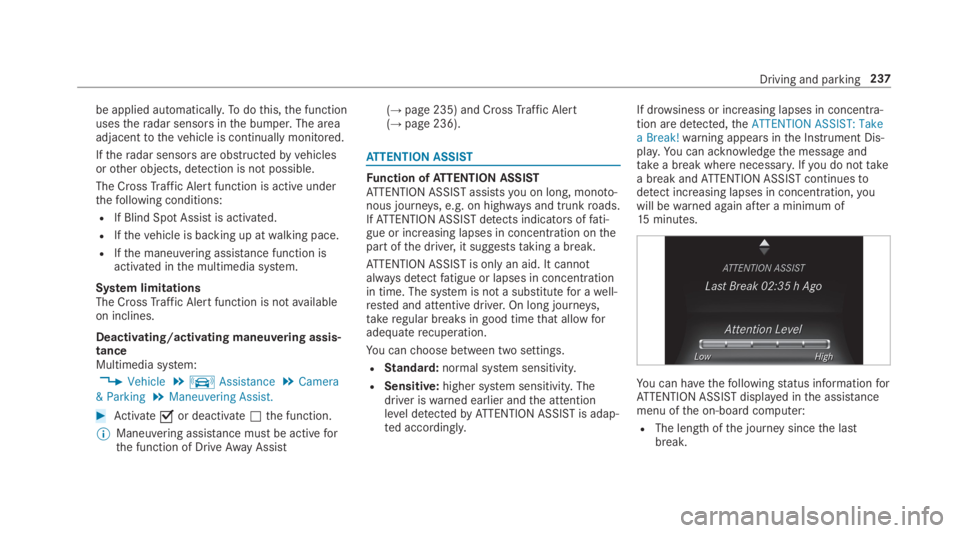
be applied automatically.Todothis,the functionusestheradar sensors inthe bumper. The areaadjacenttothevehicle is continually monitored.
Iftheradar sensors are obstructedbyvehiclesorother objects, detection is not possible.
The CrossTraffic Alert function is activeunderthefollowing conditions:
RIf Blind Spot Assist is activated.
RIfthevehicle is backing up atwalking pace.
RIfthe maneuvering assistance function isactivated inthe multimedia system.
System limitationsThe CrossTraffic Alert function is notavailableon inclines.
Deactivating/activating maneuvering assis‐tanceMultimedia system:
,Vehicle.kAssistance.Camera
& Parking.Maneuvering Assist.
#Activate�sor deactivate�Sthe function.
%Maneuvering assistance mustbe activeforthe function of DriveAwayAssist
(→page 235) and CrossTraffic Alert(→page236).
ATTENTION ASSIST
Function ofATTENTION ASSISTATTENTION ASSIST assistsyou on long, monoto‐nous journeys, e.g. on highways and trunkroads.IfATTENTION ASSIST detects indicators offati‐gue or increasing lapses in concentration onthepart ofthe driver, it suggeststaking a break.
ATTENTION ASSIST is only an aid. It cannotalways detectfatigue or lapses in concentrationin time. The system is not a substitutefor awell-rested and attentive driver. On long journeys,takeregular breaks in good timethat allowforadequaterecuperation.
You canchoose between two settings.
RStandard:normal system sensitivity.
RSensitive:higher system sensitivity. Thedriver iswarned earlier andthe attentionlevel detectedbyATTENTION ASSIST is adap‐ted accordingly.
If drowsiness or increasing lapses in concentra‐tion are detected,theATTENTION ASSIST: Takea Break!warning appears inthe Instrument Dis‐play.You can acknowledgethe message andtake a break where necessary.Ifyou do nottakea break andATTENTION ASSIST continuestodetect increasing lapses in concentration,youwill bewarned again after a minimum of15minutes.
You can havethefollowingstatus informationforATTENTION ASSIST displayed inthe assistancemenu ofthe on-board computer:
RThe length ofthe journey sincethe lastbreak.
Driving and parking237
Page 245 of 578

Display inthe assistancegraphic
1Spotlight function switched on but not oper‐ating
2Spotlight function switched on and operating
The pedestrian symbol inthe assistance graphicindicatesthestatus ofthe spotlight function. Ifthe pedestrian symbol is displayed dark1,thefunction is switched on. Ifthe symbol is dis‐
played bright2,the conditionsforthe Spotlightfunction are also fulfilled.
System limitationsThe spotlight function does notflash at animals.
The spotlight function is not active or is activeonlytoa limitedextent if:
RYou are driving in city traffic.
RThe pedestrians are located inthe area of anoncomingvehicle or avehicle in front.
Activating/deactivating the spotlight func‐tion
Requirements:RPedestrian detection is active (→page241).
RTheroadwayis not lit.
RThe speed is at least37mph (60 km/h).
RAdaptive Highbeam Assist Plus is switchedon.
If alltherequirements are fulfilled,the headlampflashesfour shortpulses at a pedestrian detec‐ted on or neartotheroadway.
Multimedia system:
,Vehicle.÷.Light Set-
tings.Spotlight
#Activate�sor deactivate�Sthe function.
Blind Spot Assist andActive Blind SpotAssistwithexitwarning
Function of Blind Spot Assist andActiveBlind Spot AssistwithexitwarningBlind Spot Assist andActive Blind Spot Assistuse two lateral,rear-facingradar sensorstomonitorthe area upto130ft(40 m) behindyourvehicle and10ft(3 m) directly nexttoyourvehi‐cle.
If avehicle is detected at speeds above approx‐imately 8mph (12 km/h) andthisvehicle subse‐quentlyentersthe monitoringrange directly nextto yourvehicle,thewarning lamp inthe outsidemirror lights upred.
If avehicle is detected closetothe side ofyourvehicle,theredwarning lamp inthe outside mir‐rorflashes. Ifyou switchonthe turn signal indi‐cator inthe corresponding direction, awarning
Driving and parking243